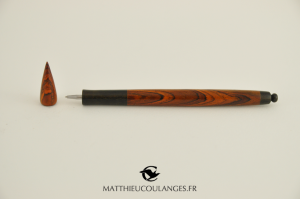Here is my vision of engraving needles with you.There are two broad categories: Etching Needles and Drypoint Needles.
- The needles for etching must be sharpened so that they will “glide » with minimal effort over the glazed plate, while engraving only a little, or not at all, the plate below the glaze. We can take into account that, if a needle lightly engraves the plate, this will help in acid priming, and promotes a homogeneous binding of the acid to the plate.
- Drypoint needles, used to engrave directly onto the plate, are a compromise between a good grip (a more or less incisive point) and a good glide on the plate (the point may be more or less blunt ).
For drypoint, there are many more suitable materials than steel for needles. There were once sapphire needle points; today we use mainly tungsten carbide and industrial diamond.
- Diamond provides an excellent balance between plate grip and and the bluntness of the point. Diamonds needles allow one to effortlessly etch zinc, copper, and even steel (I have not personally tested them on steel), and to work in light grays as well as blacks. They also have a very long lifetime. Their only fault is a relative fragility, which is because of how they are produced: a small industrial diamond is « welded » onto a steel stem. To compensate for this, it’s advisable to keep the needle almost vertical when you want to get a deep bite into the metal.
- Tungsten carbide is one of the hardest materials after diamond. The carbide needles have the advantage of being constructed out of a single piece, so there’s no risk of breakage. They are somewhat less durable than diamond-pointed needles, and the balance between plate grip and point bluntness is less desirable (a carbide needle that has the same point as a diamond one will scratch the plate somewhat less). On the other hand, you can easily play on this balance by changing the angle of the sharpened needle, to have either a very incisive point or a very soft point.
- Ceramics (zirconia, alumina…) are comparable hardness materials, or superior, to tungsten carbide. They are used as kitchen knives, but they are increasingly used in industrial level, such as scraper.
Personally I propose a type of diamond needle (ground at a relatively steep angle, so that the line is not hidden by the point), and 3 types of carbide needles:
- A very incisive needle, ideal for working in black, and a complement to a diamond point
- An intermediate needle, which has more or less the same bluntness as the diamond point, but which is a little less incisive. For those who prefer durability.
- A very blunt needle, which is perfect for sketched engravings and working in light grays…as it slides perfectly on the plate. I also use it in etching.
Ceramic tips are incisive, but more smooth to use than diamond points.And they make very small burrs.










